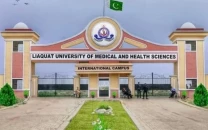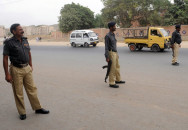Lahore Metro to carry 30,000 people per hour, experts

Lahore Metro to carry 30,000 people per hour, experts
Participants of the third seminar in the series included engineers and former civil servants. Some of them said they were shocked that the government had not invited the citizens to help name the country’s first metro system. Suleman Ghani, the LRMTS chairman, assured the anxious participants, “The civil society will be taken into confidence before an agreement is reached.” Earlier, Zahid Baig, a retired civil servant, said he was worried that there had been no meaningful consultation with the people who had, for decades, looked after the transport sector. He said that their input was important. Also, he said, they should have been the first to propose names and a logo for the project.
He sought then to take the lead in this respect and suggested that the LRMTS should be named Quaid-i-Azam Metro Train. Jabbar Huma, an engineer, said that the project should be named after a national hero, somebody for whom the people had great respect and love. “If people vote to name it Benazir Metro Train, I don’t see any harm in it,” she added. Sajida Zuberi said for her security was the biggest concern. The problem, she said had been aggravated by the on-going operation against militants. Unfortunately, she said, it was far from clear what the government planned to do to make the facilities safe.
Several consultants helping with various aspect of the project, including Alexander Jonard, Faysal El-Khoumisti, Meera Eland, Pamela Rogers and Mazhar Iqbal, also attended the seminar. Javaid Aslam, the Planning and Development Board chairman, presided over it. The speakers said for ensuring a better quality of life for all their residents, mega urban centres like metropolitan Lahore needed to develop within the framework of strategic master planning, incorporating economic parameters for efficiency gains.
They hoped that the system would minimise congestion on public transport routes, provide high quality service in terms of speed, frequency and ease of accessibility to reduce the dependence on road vehicles and facilitate safe and environmentally sustainable transport. They said in its first year of operation the Green Line will daily carry nearly 300,000 passengers. “After ascertaining the project’s economic and financial viability through the network feasibility studies and pertinent review by the Asian Development Bank, the government of Punjab has obtained ADB’s commitment to finance the infrastructure component for the LRMTS project – around 50 per cent of the project’s overall costs.
The government is considering several options including the Build-Operate-Transfer (BOT) for the metro’s rolling stock, system and operations. Initially, the metro is to have a fleet of 26 trains. Later, 27 more trains will be added. Each train will have 6 cars – a capacity of 1,040 passengers – and may include a separate section for women and children. “The trains will be around 100 metres long, around 3 metres wide and fully air-conditioned. The automated train operation system will allow a twominute headway.
This will provide un ultimate capacity of 30,000 passengers per hour in each direction.”All station platforms are planned to be 102 metres long and to have screen doors. All stations will be accessible for disabled passengers from the street to platform level. The stations are designed to contribute to the city’s image. Small shops and kiosks at these will allow the passengers to purchase newspapers, drinks and snacks, during their journey. Presiding the seminar, LRMTS planning chairman, Javaid Iqbal later gave an insight in to the project, expected to be completed in three phases.
He said that the system would minimise congestion on public transport routes as it is expected to approximately commute nearly 0.3 million passengers daily. He went to tell that a French company SYSTRA is expected to allocate more than fifty per cent of the funds for the project. The project is expected to be opened with a fleet of 26 trains during the first phase and another 27 will be added by next, the chairmen added.
Published in the Express Tribune, May 15th, 2010.


















COMMENTS
Comments are moderated and generally will be posted if they are on-topic and not abusive.
For more information, please see our Comments FAQ